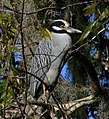
Homosassa is a census-designated place (CDP) in Citrus County, Florida, United States. The population was 2,578 at the 2010 census.

The Ichetucknee River is a spring-fed, pristine river in North Central Florida. The entire 6 miles (9.7 km) of the river average 20 feet (6.1 m) wide, 5 feet (1.5 m) deep and most of the 6 miles lie within the boundaries of the Ichetucknee Springs State Park while the rest is to the south of US Highway 27. Three Rivers Estates Property Owners (TREPO) is the property owner association that manages the area along the private side of the river as it travels and flows into the Santa Fe River.
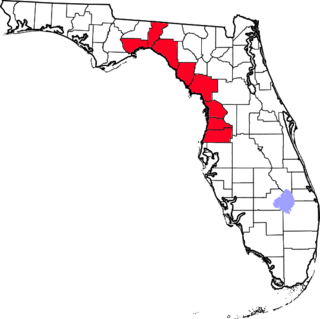
The Nature Coast is an informal, unofficial region of the U.S. state of Florida. The broadest definition of the Nature Coast includes the eight counties that abut the Gulf of Mexico along the Big Bend Coast defined by geologists: from west to east, Wakulla, Jefferson, Taylor, Dixie, Levy, Citrus, Hernando, and Pasco counties. The name "Nature Coast" was originally devised as part of a marketing campaign to promote tourism in Levy, Citrus, Hernando, and parts of Marion and Pasco counties.
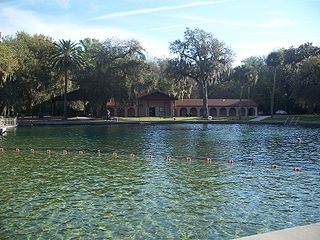
De Leon Springs State Park is a Florida State Park in Volusia County, Florida. It is located in DeLeon Springs, off CR 3.
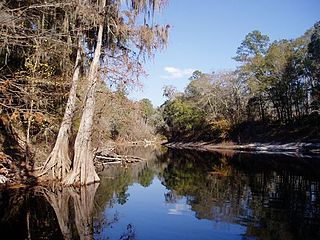
Suwannee River State Park is a Florida State Park located near Live Oak. It offers some of the best backcountry canoeing opportunities in the state. Visitors can see cypress trees, southern magnolia, herons, American coots, turtles and hawks. The park is open year-round.

Homosassa Springs Wildlife State Park is located near Homosassa Springs, Florida, in the United States. The park is one of the notable locations in the state to view manatees. Visitors can get close to the animals on a floating observatory. Black bears, bobcats, white-tailed deer, American alligators, and river otters can also been seen in the park. The park is also home to the hippopotamus Lu, famously known for his performances in many movies for the past 40 years. The park is officially named Ellie Schiller Homosassa Springs Wildlife State Park in honor of Elmyra Felburn Schiller, a benefactor of the Florida state park system.

Ichetucknee Springs State Park is a 2,241-acre (9.07 km2) Florida State Park and National Natural Landmark located 4 miles (6 km) northwest of Fort White off State Road 47 and State Road 238. It centers around the 6-mile-long (10 km) Ichetucknee River, which flows through shaded hammocks and wetlands into the Santa Fe River. The park contains hardwood hammock and limestone outcrops. Like many rivers in this part of North Florida, the Ichetucknee is fed by natural springs which boil up from the aquifer. The state of Florida purchased the property in 1970 from the Loncala Phosphate Corporation for $1,850,000.

Dr. Von D. Mizell-Eula Johnson State Park is a Florida State Park located in Dania Beach, Florida off Florida State Road A1A. The park is named for late civil rights activists Von Mizell and Eula Johnson, who first pressured Broward County to have at least one beach for African Americans, then led wade-ins in Ft. Lauderdale in 1961 that led to desegregation of the county's beaches the following year. The park's former namesake, John U. Lloyd, served as Broward County Attorney for over 30 years and was instrumental in obtaining the land for the park.

Little Manatee River State Park is a 2,433-acre (985 ha) Florida State Park located 5 miles (8.0 km) south of Sun City, off U.S. Route 301 on Lightfoot Road and along the Little Manatee River. The park was established in 1974 as Little Manatee River State Recreation Area with 663 hectares. It was designated as a state park in March 1999. The Florida Department of Environmental Protection's Division of Recreation and Parks manages that park under a 99-year lease, set to expire April 10, 2074.

Werner-Boyce Salt Springs State Park is a Florida state park located in Pasco County, Florida near Port Richey, Florida, along the Gulf of Mexico on the Atlantic coastal plain. An entrance to this park is at the intersection of Scenic Drive and Cinema Drive, one mile west of the intersection of Cinema Drive/Ridge Manor Blvd. and U.S. Highway 19. The park is named, in part, for a 320 feet deep saltwater spring in the park, which is not yet easily accessible. The park includes four miles of Pasco County's coastal waters on the Gulf of Mexico.

Rainbow Springs State Park is a Florida state park located on U.S. 41, 3 miles (5 km) north of Dunnellon, Florida. It comprises 1,459.07 acres (5.9046 km2) upland and 12.83 acres (51,900 m2) submerged. The most significant natural feature is the first-magnitude headspring basin, which produces up to 600,000,000 US gallons (2,300,000 m3) of fresh water per day, forming the Rainbow River. The looking-glass waters of Rainbow Springs come from several vents, not one large bubbling spring. The river itself supports a wide variety of fish, wildlife, and plants, many within easy viewing by visitors. In total, the park contains 11 distinct natural communities, including sandhills, flatwoods, upland mixed forests, and hydric hammocks.

Tomoka State Park is an 2,000-acre (8.1 km2) Florida State Park located along the Tomoka River, three miles (5 km) north of Ormond Beach on North Beach Street.

Wekiwa Springs State Park is a 7,000-acre (28 km2) Florida State Park in Apopka, Florida. It is located 20 minutes north of Orlando, off Interstate 4 at exit 94, near Altamonte Springs and Longwood. The park also contains the head water of the Wekiva River. It also serves as the headquarters of one of the state's five AmeriCorps Florida State Parks chapters.

Lafayette Blue Springs State Park is a Florida State Park, located on the west side of the Suwannee River, seven miles northwest of Mayo, off US 27. It contains one of the state's 33 first magnitude springs, with a daily discharge of up to 168 million gallons.
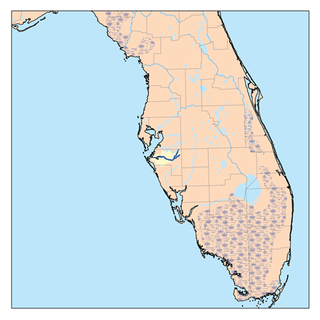
The Manatee River is a 36-mile-long (58 km) river in Manatee County, Florida. The river forms in the northeastern corner of Manatee County and flows into the Gulf of Mexico at the southern edge of Tampa Bay.

In 1999, the Guana Tolomato Matanzas National Estuarine Research Reserve was designated in St. Johns and Flagler counties, Florida as a part of the National Oceanic and Atmospheric Administration (NOAA) National Estuarine Research Reserve (NERR) system. The GTM Research Reserve represents the east Florida sub-region of the Carolinian bioregion. It is one of 30 NERRs in 23 states and one territory. GTM is one of three NERRs in Florida and is administered on behalf of the state by the Florida Department of Environmental Protection's Florida Coastal Office as part of a network that includes forty-one aquatic preserves, three NERRs, a National Marine Sanctuary, the Coral Reef Conservation Program and the Florida Oceans and Coastal Council. Additional interests are held in the research and management of the GTM and connected preserved or conserved lands including:

Three Sisters Springs is located on the Crystal River, in Citrus County, Florida, United States, at 28.888725°N 82.589191°W. It is in a natural inlet on the east side of Kings Bay. It contains three spring areas that contain many sand boils and vents. The land surrounding the springs is privately owned property and there is no landfall or boat tie-up permitted; the only access to the springs is blocked by concrete posts to stop the boats from entering. Only kayaks, canoes, and swimmers are permitted in the area. Three Sisters Springs is also home to many manatees and is one of the Crystal River's sanctuaries.

The Lake George State Forest is a designated protected area and state forest in the U.S. state of Florida. The 21,176-acre (8,570 ha) forest is located in northwestern Volusia County, Florida, near Lake George and the communities of Pierson, Barberville, and Volusia. It is overseen by the Florida Forest Service within the Florida Department of Agriculture and Consumer Services.
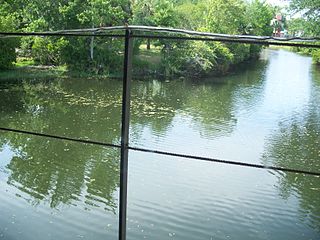
Homosassa River is a 7.7-mile-long (12.4 km) river in Citrus County, Florida, in the western part of the state. Its headwaters are the Homosassa Springs, and from there it flows west into the Gulf of Mexico. The river is home to common bottlenose dolphins, West Indian manatees, alligator snapping turtles, nine-banded armadillos, snakes, birds, eastern box turtles, oysters, raccoons, American alligators, Virginia opossums, North American river otters and many species of both freshwater and saltwater fish. The Homosassa River is an estuary, which means that as it moves inland, it changes from salt water to fresh very gradually, and the river is brackish. The river is good for canoeing and kayaking.
The North Fork St. Lucie River Aquatic Preserve (NFSLR) is a freshwater and brackish water system connected to St. Lucie Estuary in Florida. It was designated as an aquatic preserve in 1972.











